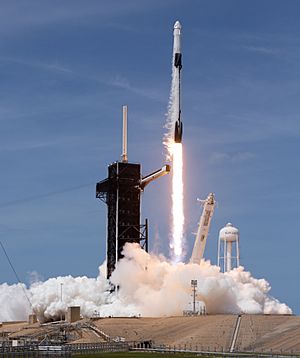Falcon 9 facts for kids
 |
|

|
|
| Function | Orbital launch vehicle |
|---|---|
| Manufacturer | SpaceX |
| Country of origin | United States |
| Cost per launch | US$67 million (2022) |
| Size | |
| Height |
|
| Diameter | 3.7 m (12 ft) |
| Mass |
|
| Stages | 2 |
| Capacity | |
| Payload to Low Earth orbit (LEO) |
|
| Payload to Geosynchronous transfer orbit (GTO) |
|
| Payload to Mars transfer orbit | FT: 4,020 kg (8,860 lb) |
| Associated rockets | |
| Derivatives | Falcon Heavy |
| Launch history | |
| Status |
|
| Launch sites |
|
| Total launches |
|
| Successes |
|
| Failures | 1 (v1.1: CRS-7 in-flight) |
| Partial failures | 1 (v1.0: CRS-1) |
| Other | 1 (FT: AMOS-6 pre-flight destruction) |
| Landings | Template:Falcon rocket statistics / Template:Falcon rocket statistics attempts |
| First flight |
|
| Last flight |
|
| First stage | |
| Engines |
|
| Thrust |
|
| Specific impulse |
|
| Burn time |
|
| Fuel | LOX / RP-1 |
| Second stage | |
| Engines |
|
| Thrust |
|
| Specific impulse |
|
| Burn time |
|
| Fuel | LOX / RP-1 |
Falcon 9 is a partially reusable medium-lift launch vehicle that can carry cargo and crew into Earth orbit, designed, manufactured and launched by American aerospace company SpaceX. It can also be used as an expendable heavy-lift launch vehicle. The first Falcon 9 launch was on 4 June 2010. The first Falcon 9 commercial resupply mission to the International Space Station (ISS) launched on 8 October 2012. In 2020 it became the first commercial rocket to launch humans to orbit and remains the only such vehicle. It is the only U.S. rocket certified for transporting humans to the ISS. In 2022, it became the U.S. rocket with the most launches in history and with the best safety record, having suffered just one flight failure.
The rocket has two stages. The first (booster) stage carries the second stage and payload to a pre-determined speed and altitude, after which the second stage accelerates the payload to its target orbit. The booster is capable of landing vertically to facilitate reuse. This feat was first achieved on flight 20 in December 2015. As of Template:Falcon rocket statistics, SpaceX has successfully landed Falcon 9 boosters Template:Falcon rocket statistics times. Individual boosters have flown as many as 19 flights. Both stages are powered by SpaceX Merlin engines, using cryogenic liquid oxygen and rocket-grade kerosene (RP-1) as propellants.
The heaviest payloads flown to geostationary transfer orbit (GTO) were Intelsat 35e carrying 6,761 kg (14,905 lb), and Telstar 19V with 7,075 kg (15,598 lb). The former was launched into an advantageous super-synchronous transfer orbit, while the latter went into a lower-energy GTO, with an apogee well below the geostationary altitude. On 24 January 2021, Falcon 9 set a record for the most satellites launched by a single rocket, carrying 143 into orbit.
Falcon 9 is human-rated for transporting NASA astronauts to the ISS. Falcon 9 is certified for the National Security Space Launch program and NASA Launch Services Program as "Category 3", which can launch the most expensive, important, and complex NASA missions.
Several versions of Falcon 9 have been built and flown: v1.0 flew from 2010–2013, v1.1 flew from 2013–2016, while v1.2 Full Thrust first launched in 2015, encompassing the Block 5 variant, which has been in operation since May 2018.
Related pages
Images for kids
-
Falcon 9 Flight 20 historic first-stage landing at CCAFS, Landing Zone 1, on 21 December 2015.
-
A Falcon 9 v1.0 being launched with a Dragon spacecraft to deliver cargo to the ISS in 2012.
-
Falcon 9's first stage successfully landing on an ASDS for the first time, following the launch of SpaceX CRS-8 to the ISS.
-
SpaceX's Falcon 9 rocket delivered the ABS-3A and Eutelsat 115 West B satellites to a supersynchronous transfer orbit, launching from Space Launch Complex 40 at Cape Canaveral Air Force Station, Florida in March 2015.
See also
 In Spanish: Falcon 9 para niños
In Spanish: Falcon 9 para niños







